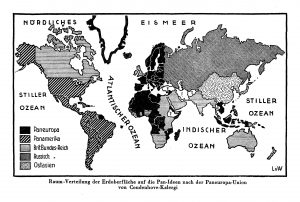September 23, 2019, by Benjamin Thorpe
CFP: AAG 2020, “Pan-movements: between nation and globe”

“Spatial distribution of Pan-Ideas on the Earth’s surface, after Coudenhove-Kalergi’s Pan-European Union”. From Karl Haushofer, Geopolitik der Pan-Ideen (Berlin: Zentral-Verlag; 1931), p. 9
Pan-movements: between nation and globe
AAG Annual Meeting, Denver, 6-10 April 2020
Pan-movements (pan-Slavism, pan-Islamism, pan-Africanism, etc.), which proliferated in the late 19th and early-20th centuries, were a hugely popular genre of political affiliation. They appealed to supranational identities unified by ethnic, religious, geographical or other form of likeness. These movements were marked by their variety: variety in their formalised structures, in the nature of their politics, and in their appeal and reach. Whilst at times pan-movements were imperialistic, supported by various geopolitical theorists (c.f. Haushofer, 1931), they were also vehicles for emancipatory and anti-colonial politics.
Recently, historians and international relations scholars have cast a renewed, critical eye at pan-Asian (Saaler & Szpilman, 2011; Weber, 2018; Roberts, 2018), pan-African (Adi, 2018; Tageldin, 2014), pan-American (Davis, 2018), pan-European (Sorrels, 2016), pan-Islamic (Aydin, 2007), pan-Turanist (Levent, 2016) movements and others. Despite the difficulty in defining their precise shape, these movements were important political-historical forces which prompt us to provincialise taken-for-granted understandings of internationalism.
Yet, geographers – perhaps cautious of their geopolitical associations – have rarely engaged with pan-movements, and 2020 will mark 30 years since the publication of O’Loughlin and van der Wusten’s (1990) article on the “Political Geography of Panregions”. However, pan-movements often explicitly mobilised geographical ideas and knowledge. In this session we invite papers which address pan-movements of all origins (geographical, religious, ethnic) and forms (political, cultural, intellectual). Papers might engage with, but are not limited to, one or some of the following areas:
- The development of pan-movements – the history of pan-nationalist ideas, their institutional forms or key actors, as well as comparisons between them.
- The influence of pan-movements – their politics or historiography, the strengths or limitations of ‘pan-’ thinking, and why the term became a geopolitical trope when it does
- The relationship between pan- thinking and other big-space geographical ideas (cosmopolitanism, internationalism, imperialism, etc.)
- The use of pan-ideology to support modern irredentist and imperialist ideologies
- The relationship between pan-movements and nationalist movements
- The role of economic associations and arguments in pan-movements
Please submit paper titles and abstracts (250 words max) via email by Monday 14 October 2019 to Jake Hodder (jake.hodder@nottingham.ac.uk) and Ben Thorpe (benjamin.thorpe@nottingham.ac.uk).
References
Adi, H. 2018 Pan-Africanism: A History (London: Bloomsbury Academic)
Aydin, C. 2007 The Politics of Anti-Westernism in Asia: Visions of World Order in Pan-Islamic and Pan-Asian Thought (New York & Chichester: Columbia University Press)
Davis, T.E. 2018 “The tragedy of Americanist diplomacy: Pan-American networks and the consolidation of empire, 1910–1917” International Politics 55(6): 734-751.
Haushofer, K. 1931 Geopolitik der Pan-Ideen (Berlin: Zentral-Verlag).
Levent, S. 2016 “Common Asianist intellectual history in Turkey and Japan: Turanism” Central Asian Survey 35(1): 121-135
O’Loughlin, J. & van der Wusten, H. 1990 “Political Geography of Panregions” Geographical Review 80(1): 1-20
Roberts, P. 2018 “The institute of pacific relations: Pan-pacific and pan-asian visions of international order” International Politics 55(6): 836-851
Sorrels, K. 2016 Cosmopolitan outsiders: imperial inclusion, national exclusion, and the pan-european idea, 1900-1930 (New York: Palgrave Macmillan)
Saaler, S. & Szpilman, C.W.A. (eds) 2011 Pan-Asianism: A Documentary History, 2 vols (Lanham, MD: Rowman & Littlefield)
Tageldin, S.M. 2014 “The Place of Africa, in Theory: Pan-Africanism, Postcolonialism, Beyond” Journal of Historical Sociology 27(3): 302-323
Weber, T. 2018 Embracing ‘Asia’ in China and Japan: Asianism Discourse and the Contest for Hegemony, 1912-1933 (Cham: Palgrave Macmillan)
No comments yet, fill out a comment to be the first

Leave a Reply